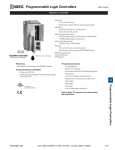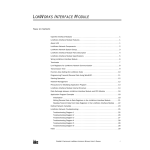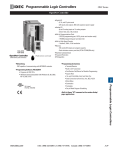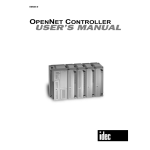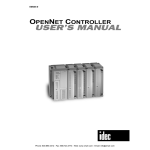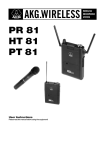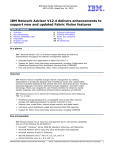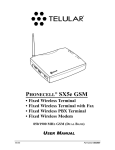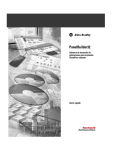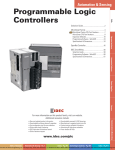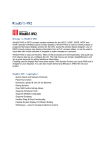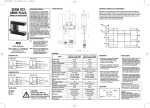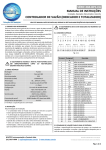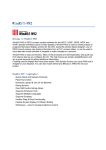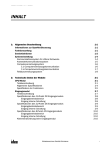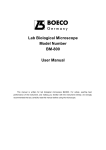Download DEVICENET SLAVE MODULE
Transcript
Modified September 28, 1999 5:26 pm Manual No. EM335-0 DEVICENET SLAVE MODULE Introduction This manual describes DeviceNet slave module FC3A-SX5DS1 used with the OpenNet Controller to interface with the DeviceNet network. Read this chapter to understand the DeviceNet system setup and the slave module specifications. For general information about safety precautions, installation, wiring, and dimensions, see the OpenNet Controller user’s manual EM333. OpenNet Interface Module The OpenNet Controller can be linked to three major open networks; INTERBUS, DeviceNet, and LONWORKS. For communication through these networks, OpenNet interface modules are available. Mounting the DeviceNet slave module beside the OpenNet Controller CPU module makes a slave station used as an I/O terminal in a DeviceNet network. The slave station can transfer I/O data to and from the master station just as an ordinary I/O module in a distributed network. DeviceNet Slave Module Features Since the FC3A-SX5DS1 module conforms to the DeviceNet specifications, the OpenNet Controller can be linked to DeviceNet networks consisting of DeviceNet compliant products from many different vendors, such as I/O terminals, sensors, drives, operator interfaces, and barcode readers. The transmit/receive data quantity can be selected from 0 through 8 bytes (64 bits) in 1-byte increments. One DeviceNet slave module enables the OpenNet Controller CPU module to transmit 64 bits and receive 64 bits at the maximum to and from the DeviceNet master station. About DeviceNet DeviceNet has been originally developed by Allen-Bradley of the USA as a network for sensors, actuators, and other discrete devices, and later the specifications have been opened. Now, major automotive manufactures and various industries employ the DeviceNet networks. DeviceNet Features The network configuration is based on the bus system. The basic network consists of a trunkline-dropline topology, and multi-drop or daisy-chain configuration is also possible. The DeviceNet protocol is based on CAN (Controller Area Network) which has been widely used for networks on automobiles, making it possible to configure reliable networks with high noise immunity. Transmission Distance and Nodes The maximum transmission distance is 500 meters when using a thick trunk cable at a data rate of 125k baud, and the maximum quantity of nodes is 64 including a master station. DeviceNet is a registered trademark of Open DeviceNet Vendor Association, Inc. (ODVA). OPENNET CONTROLLER DEVICENET SLAVE MODULE USER’S MANUAL 1 Modified September 28, 1999 5:26 pm DEVICENET SLAVE MODULE System Setup Various DeviceNet compliant devices can be connected to the DeviceNet network. The DeviceNet network requires a DeviceNet master module available from other vendors. The OpenNet Controller can make up a slave station by installing the FC3A-SX5DS1 module to the right of the OpenNet Controller CPU module. A maximum of seven OpenNet interface modules and analog I/O modules can be mounted with one OpenNet Controller CPU module. DeviceNet Master Station DeviceNet STATUS MODULE NET ADDRESS/ERROR Example: Rockwell Automation SLC Processor with 1747-SDN DeviceNet Scanner DeviceNet Network POWER POW MNS IO RUN ERROR HSC OUT COM A NO H/L DR1 DR0 NA5 NA4 NA3 NA2 NA1 NA0 0 1 2 3 4 5 6 7 10 11 12 13 14 15 16 17 B RS485 Z HSC OUT A B G +24V 0V IDEC SX5D Communication Terminal idec IDEC OpenNet Controller CPU Module I/O Module DeviceNet Slave Module FC3A-SX5DS1 IDEC SX5D Communication Terminal Other DeviceNet Compliant Devices 2 OPENNET CONTROLLER DEVICENET SLAVE MODULE USER’S MANUAL Modified September 28, 1999 5:26 pm DEVICENET SLAVE MODULE Parts Description Expansion Connector (1) Module ID (5) Status LED (2) DIP Switch (4) Color Label (3) Network Interface Connector OpenNet Interface Module for DeviceNet Module Name DeviceNet Slave Module Type No. FC3A-SX5DS1 (1) Module ID FC3A-SX5DS1 indicates the DeviceNet slave module ID. (2) DIP Switch 10-pole DIP switch for setting node address, data rate, and output hold/load off (3) Network Interface Connector (4) Color Label (5) Status LED For connecting the DeviceNet communication cable A five-color label is located beside the connector on the FC3A-SX5DS1 module. Connect each of the five different-color wires of the DeviceNet communication cable to the terminal of a matching color. Label and Wire Insulation Color Name Black V– Blue CAN_L Bare Wire Drain White CAN_H Red V+ Indicates operating status Indicator Status — POW (power) MNS (module/network status) Module power OFF Green ON Module power ON — OFF Power OFF or Dup_MAC_ID test not completed Flash Normal operation (communication not established) ON Normal operation (communication established) Green Red — IO (I/O status) OFF Description Green Red Flash Minor fault (temporary network error) ON Critical fault OFF I/O inactive (communication not established) Flash I/O idle (communication established) ON I/O active ON I/O error or communication interrupted OPENNET CONTROLLER DEVICENET SLAVE MODULE USER’S MANUAL 3 Modified September 28, 1999 5:26 pm DEVICENET SLAVE MODULE Specifications General Specifications Communication Interface Power Voltage Range 11 to 25V DC Current Draw Approx. 25 mA Isolation Between control circuit and communication terminal: Photocoupler isolated Insulation Resistance Between communication terminal and FG: 10 MΩ minimum (500V DC megger) Dielectric Strength Between communication terminal and FG: 1000V AC, 1 minute (10 mA maximum) Vibration Resistance 10 to 57 Hz, amplitude 0.075 mm; 57 to 150 Hz, acceleration 9.8 m/sec2 (1G); 10 sweep cycles each in 3 axes (total 80 minutes) (IEC1131) Shock Resistance 147 m/sec2 (15G), 11 msec, 3 shocks each in 3 axes (IEC1131) Altitude Operation: 0 to 2000m Transportation: 0 to 3000m Operating Temperature 0 to +55°C (no freezing) Operating Humidity 30 to 90% RH (no condensation) Storage Temperature –25 to +75°C Storage Humidity 30 to 90% RH (no condensation) Corrosion Immunity Free from corrosive gases Mounting Snap-on mount on 35-mm DIN rail Weight (approx.) 180g Communication Specifications • Data Rate and Transmission Distance Data Rate Max. Cable Distance for 100% Thick Cable Max. Cable Distance for 100% Thin Cable Max. Drop Line Length Max. Total Drop Line Length 500k baud 100m 100m 6m 39m 250k baud 250m 100m 6m 78m 125k baud 500m 100m 6m 156m • Maximum Number of Stations in the Network 64 stations (including a master) • Communication Data Length Transmit: Receive: 0 to 8 bytes (selectable in 1-byte increments) 0 to 8 bytes (selectable in 1-byte increments) • Network Interface Connector In the module: To the cable: MSTB2.5/5-GF-5.08AU (made by Phoenix Contact) FRONT-MSTB2.5/5-STF-5.08AU (made by Phoenix Contact) • Communication Cable (Special DeviceNet Cable) • Terminator Thick Cable Type No. Thin Cable Type No. Maker 1485C-P1A50 1485C-P1-C150 Rockwell Automation For details about cables, consult Rockwell Automation. Terminators must be connected to both ends of the DeviceNet network. When setting up a network, either connect commercially-available terminators at both ends of the network or connect the following resistor to the branch taps at both ends of the network. Metal film resistor: 121Ω, ±1%, 1/4W 4 OPENNET CONTROLLER DEVICENET SLAVE MODULE USER’S MANUAL Modified September 28, 1999 5:26 pm DEVICENET SLAVE MODULE Wiring DeviceNet Cable Precautions for Wiring • Do not run the network cable in parallel with or near power lines, and keep the network cable away from noise sources. • Power down the DeviceNet slave module before starting wiring. Make sure of correct wiring before powering up the DeviceNet slave module. • Use the special DeviceNet cable for connecting the network. • A five-color label is located beside the connector on the DeviceNet slave module. Connect each of the five differentcolor wires of the cable to the terminal of a matching color. • When using thick cables, only one wire can be connected a terminal of the network interface connector. To connect two wires of thick cables, use a device tap. • Tighten the mounting screws of the network interface connector to a recommended torque of 0.3 to 0.5 N-m. • Tighten the terminal screws of the network interface connector to a recommended torque of 0.5 to 0.6 N-m. • Either connect commercially-available terminators at both ends of the network or connect the following resistor to the branch taps at both ends of the network. Connect the terminator between the CAN_H (white) and CAN_L (blue) lines. Metal film resistor: 121Ω, ±1%, 1/4W Ferrules, Crimping Tool, and Screwdriver for Phoenix Terminal Blocks The screw terminal block of the network interface connector can be wired with or without using ferrules on the end of the cable. Applicable ferrules for the terminal block and crimping tool for the ferrules are listed below. The screwdriver is used to tighten the screw terminals on the DeviceNet slave module. These ferrules, crimping tool, and screwdriver are made by Phoenix Contact and are available from Phoenix Contact. Type numbers of the ferrules, crimping tool, and screwdriver listed below are the type numbers of Phoenix Contact. When ordering these products from Phoenix Contact, specify the Order No. and quantity listed below. DeviceNet slave modules are connected to the network using special DeviceNet thick or thin cables, each cable consisting of three different sizes of wires listed below. • Ferrule Order No. Applicable Wire Size mm2 AWG 0.25 24 0.5 20 0.75 18 1.0 18 1.5 16 2.5 14 For 1-wire connection Phoenix Type Order No. AI 0,25-8 YE 32 00 85 2 AI 0,5-8 WH 32 00 01 4 AI 0,75-8 GY 32 00 51 9 AI 1-8 RD 32 00 03 0 AI 1,5-8 BK 32 00 04 3 AI 2,5-8 BU 32 00 52 2 For 1-wire Connection For 2-wire connection Phoenix Type Order No. — — AI-TWIN 2 x 0,5-8 WH 32 00 93 3 AI-TWIN 2 x 0,75-8 GY 32 00 80 7 AI-TWIN 2 x 1-8 RD 32 00 81 0 AI-TWIN 2 x 1,5-8 BK 32 00 82 3 — — Dimension A 0,25-8 YE 4.5 mm 0,5-8 WH 0,75-8 GY 1-8 RD 6.0 mm 1,5-8 BK 2,5-8 BU For 2-wire connection Ferrule A 8.0 mm AI AI AI AI AI AI Pcs./Pkt. Ferrule AI-TWIN AI-TWIN AI-TWIN AI-TWIN B 2 2 2 2 x 0,5-8 WH x 0,75-8 GY x 1-8 RD x 1,5-8 BK 100 100 100 100 100 100 Dimension B 7.0 mm 8.0 mm 8.0 mm • Crimping Tool and Screwdriver Order No. Tool Name Crimping Tool Screwdriver Phoenix Type CRIMPFOX UD 6 SZS 0,6 x 2,5 Order No. 12 04 43 6 12 05 04 0 Pcs./Pkt. 1 10 OPENNET CONTROLLER DEVICENET SLAVE MODULE USER’S MANUAL 5 Modified September 28, 1999 5:26 pm DEVICENET SLAVE MODULE DIP Switch Settings DIP switches are inside the protective lid. After setting the DIP switches, replace the lid into position. ON NO 1 All DIP switches are set to off before shipping from factory. H/L 2 Set the DIP switches to select the node address (MAC ID: media access control identifier), data rate, and output hold/load off. DR1 3 DR0 4 Do not set the DIP switches to the “Selection Prohibited” positions. NA5 5 NA4 6 NA3 7 NA2 8 NA1 9 NA0 10 Node Address (MAC ID) Node Address 0 1 2 3 4 5 6 7 8 9 10 11 12 13 14 15 16 17 18 19 20 21 22 23 24 25 26 27 28 29 30 31 NA0 OFF ON OFF ON OFF ON OFF ON OFF ON OFF ON OFF ON OFF ON OFF ON OFF ON OFF ON OFF ON OFF ON OFF ON OFF ON OFF ON NA1 OFF OFF ON ON OFF OFF ON ON OFF OFF ON ON OFF OFF ON ON OFF OFF ON ON OFF OFF ON ON OFF OFF ON ON OFF OFF ON ON NA2 OFF OFF OFF OFF ON ON ON ON OFF OFF OFF OFF ON ON ON ON OFF OFF OFF OFF ON ON ON ON OFF OFF OFF OFF ON ON ON ON Data Rate Data Rate 125k baud 250k baud 500k baud (Selection Prohibited) 6 NA3 OFF OFF OFF OFF OFF OFF OFF OFF ON ON ON ON ON ON ON ON OFF OFF OFF OFF OFF OFF OFF OFF ON ON ON ON ON ON ON ON NA4 OFF OFF OFF OFF OFF OFF OFF OFF OFF OFF OFF OFF OFF OFF OFF OFF ON ON ON ON ON ON ON ON ON ON ON ON ON ON ON ON NA5 OFF OFF OFF OFF OFF OFF OFF OFF OFF OFF OFF OFF OFF OFF OFF OFF OFF OFF OFF OFF OFF OFF OFF OFF OFF OFF OFF OFF OFF OFF OFF OFF Node Address 32 33 34 35 36 37 38 39 40 41 42 43 44 45 46 47 48 49 50 51 52 53 54 55 56 57 58 59 60 61 62 63 NA0 OFF ON OFF ON OFF ON OFF ON OFF ON OFF ON OFF ON OFF ON OFF ON OFF ON OFF ON OFF ON OFF ON OFF ON OFF ON OFF ON NA1 OFF OFF ON ON OFF OFF ON ON OFF OFF ON ON OFF OFF ON ON OFF OFF ON ON OFF OFF ON ON OFF OFF ON ON OFF OFF ON ON Output Hold or Load Off DR0 OFF ON OFF ON DR1 OFF OFF ON ON Output/Load LOAD OFF HOLD H/L OFF ON OPENNET CONTROLLER DEVICENET SLAVE MODULE USER’S MANUAL NA2 OFF OFF OFF OFF ON ON ON ON OFF OFF OFF OFF ON ON ON ON OFF OFF OFF OFF ON ON ON ON OFF OFF OFF OFF ON ON ON ON NA3 OFF OFF OFF OFF OFF OFF OFF OFF ON ON ON ON ON ON ON ON OFF OFF OFF OFF OFF OFF OFF OFF ON ON ON ON ON ON ON ON NA4 OFF OFF OFF OFF OFF OFF OFF OFF OFF OFF OFF OFF OFF OFF OFF OFF ON ON ON ON ON ON ON ON ON ON ON ON ON ON ON ON NA5 ON ON ON ON ON ON ON ON ON ON ON ON ON ON ON ON ON ON ON ON ON ON ON ON ON ON ON ON ON ON ON ON System Reserve System Reserve Fixed to (Selection Prohibited) NO OFF ON Modified September 28, 1999 5:26 pm DEVICENET SLAVE MODULE Link Register Allocation in the CPU Module DeviceNet communication data is stored to link registers in the OpenNet Controller CPU module and the data is communicated through the DeviceNet slave module. Since seven functional modules including the DeviceNet slave module can be mounted with one OpenNet Controller CPU module, link registers are allocated depending on the position where the DeviceNet slave module is mounted. Link Register Allocation Numbers Allocation Number L*00 L*01 L*02 L*03 L*04 L*05 L*06 L*07 L*12 L*13 L*14 L*24 Area Data area Data area Data area Data area Data area Data area Data area Data area Status area Status area Status area Reserved area Function Receive data Receive data Receive data Receive data Transmit data Transmit data Transmit data Transmit data Error data I/O counts Connection status Software version Description Stores received data from the network Stores received data from the network Stores received data from the network Stores received data from the network Stores transmit data for the network Stores transmit data for the network Stores transmit data for the network Stores transmit data for the network Stores various error codes Stores the byte counts of transmit/receive data Stores the allocation choice byte Stores the system software version R/W Read Read Read Read Write Write Write Write Read Read Read Read Note: A number 1 through 7 comes in place of * depending on the position where the functional module such as OpenNet interface module or analog I/O module is mounted. Consequently, operand numbers are automatically allocated to each functional module in the order of increasing distance from the CPU module, starting with L100, L200, L300, through L700. Error Data (Status Area) L*12 L*12 b15 b14: unused b13 b12-b9: unused b8 b7-b0: unused When an error occurs, the MNS or IO LED on the DeviceNet slave module goes on or flashes depending on the error and a corresponding bit in the link register goes on. The status LED goes off when the cause of the error is removed. The error data bit remains on until the CPU is powered up again or reset. b15 (initialization error) This bit goes on when the CPU module fails to acknowledge the completion of initialization for communication with the DeviceNet slave module. b13 (I/O error) This bit goes on when an error occurs during communication through the CPU bus. b8 (communication fault) This bit goes on when a communication fault is detected. I/O Counts (Status Area) L*13 L*13 b15-b12: transmit bytes b11-b8: receive bytes b7-b0: unused This link register stores the transmit and receive byte counts selected in the Function Area Setting > Open Bus in WindLDR. Connection Status (Status Area) L*14 L*14 b15-b8: allocation choice b7-b0: unused This link register stores the data of the allocation choice byte. Soft Version (Reserved Area) L*24 L*24 b15-b12: major revision b11-b8: minor revision b7-b0: unused This link register stores the system software version number. [Example] Version 1.3 — 1: major revision, 3: minor revision OPENNET CONTROLLER DEVICENET SLAVE MODULE USER’S MANUAL 7 Modified September 28, 1999 5:26 pm DEVICENET SLAVE MODULE Function Area Setting for DeviceNet Slave Station The quantity of transmit/receive data for DeviceNet network communication is specified using the Function Area Setting in WindLDR. The OpenNet Controller CPU module at the DeviceNet slave station recognizes functional modules automatically at power-up and exchanges data with the DeviceNet master station through the link registers allocated to each slave station (node). Since these settings relate to the user program, the user program must be downloaded to the OpenNet Controller after changing any of these settings. Programming WindLDR 1. From the WindLDR menu bar, select Configure > Function Area Settings. The Function Area Setting dialog appears. 2. Select the Open Bus tab. Configure Communication Master Module Check Box Check this box only when the remote I/O master module is used. Quantity of Nodes Connected When using the remote I/O master module, specify the quantity of nodes from 1 through 32. Slave Station Transmit/Receive Data Quantity (Bytes) When using OpenNet interface modules for DeviceNet, INTERBUS, or LONWORKS, specify the data bytes to communicate through each OpenNet interface module. Transmit/Receive Bytes 0 to 8 (default: 8 bytes) This value determines the data quantity 0 through 8 bytes to communicate with the DeviceNet or other master module. For the example on the next page, select 8 transmit bytes and 4 receive bytes for Module 1. 3. Select transmit and receive data bytes for the slave module position 1 through 7 where the slave module is mounted. 4. Click the OK button and download the user program to the OpenNet Controller. 8 OPENNET CONTROLLER DEVICENET SLAVE MODULE USER’S MANUAL Modified September 28, 1999 5:26 pm DEVICENET SLAVE MODULE Programming a User Program on WindLDR The OpenNet interface module exchanges data between the open network and the link registers in the CPU module allocated to the OpenNet interface module, depending on the slot where the OpenNet interface module is mounted. To create a communication program for an OpenNet interface module, first determine the slot number where the OpenNet interface module is mounted, and make a program to write data to link registers allocated to transmit data and to read data from link registers allocated to receive data. Example: When an OpenNet interface module is mounted in the first slot of all functional modules MOV(W) S1 – 65535 D1 R L104 REP 4 MOV(W) S1 R L100 D1 R D0 REP 2 I0 I1 65535 → L104 through L107 When input I0 is on, constant 65535 (FFFFh) designated by source operand S1 is moved to four link registers L104 through L107 designated by destination operand D1. All 64 bits (8 bytes) in link registers L104 through L107 are turned on. Since link registers L104 through L107 are for transmit data, the data is transmitted to the network. L100·L101 → D0·D1 When input I1 is on, 32-bit (4-byte) data in two link registers L100 and L101 designated by source operand S1 is moved to data registers D0 and D1 designated by destination operand D1. Since link registers L100 and L101 are for receive data, communication data is read from the network to L100 and L101, then moved to data registers D0 and D1. Starting Operation Set up the OpenNet Controller CPU and DeviceNet slave modules, and download the user program to the CPU module. Connect the DeviceNet slave module to the DeviceNet network using DeviceNet cables. Power up the CPU module and start the CPU module to run, then DeviceNet communication starts. The delay until the communication starts after powerup depends on the size of the user program and the system setup. While the CPU is stopped, data exchange between the CPU and DeviceNet slave modules is halted, but communication with the DeviceNet network continues. Data exchange between the CPU and DeviceNet slave modules is asynchronous with the user program scanning in the CPU module. OPENNET CONTROLLER DEVICENET SLAVE MODULE USER’S MANUAL 9 Modified September 28, 1999 5:26 pm DEVICENET SLAVE MODULE Transmission Time The response time of the DeviceNet network varies greatly depending on such factors as the quantity of nodes, data bytes, and DeviceNet system setup. To determine the accurate response time, confirm the response time on the actual network system. The following example describes a response time in a DeviceNet system comprising IDEC SX5D series communication terminals. Example: DeviceNet Transmission Time • System Setup PLC: 1747-L532 (SLC5/03 CPU made by Rockwell Automation) Master: 1747-SDN (SLC500 DeviceNet Scanner Module made by Rockwell Automation) Slave: SX5D-SBM16K (8pt transistor source input / 8pt transistor sink output) SX5D-SBM16P (8pt transistor sink input / 8pt transistor protect source output) SX5D-SBR08 (8pt relay output) Data Rate: 125k baud Operation Mode: Communication according to the scan list in the master • System Operation (Data Flow) (1) SX5D-SBM16K sends 8-input data to the master, and the master sends 8-output data to SX5D-SBM16K. (2) SX5D-SBM16P sends 8-input data to the master, and the master sends 8-output data to SX5D-SBM16P. (3) SX5D-SBM16K sends 8-input data to the master, and the master sends 8-output data to SX5D-SBR08. • Calculating the Response Time Response time = Input processing time (slave) + Communication time (slave to master) + Data processing time (master and PLC) + Communication time (master to slave) + Output processing time (slave) • Measured Value of Response Time SX5D-SBM16K Input ON/OFF → SX5D-SBM16K Output ON/OFF response time = Approx. 18 msec PLC (1747-L532) Node 0 (MAC ID = 0) DeviceNet STATUS MODULE NET ADDRESS/ERROR DeviceNet Master (1747-SDN) Power Supply Module DeviceNet Network 10 Node 1 (MAC ID = 1) Node 2 (MAC ID = 2) Node 3 (MAC ID = 3) SX5D-SBM16K SX5D-SBM16P SX5D-SBR08 OPENNET CONTROLLER DEVICENET SLAVE MODULE USER’S MANUAL Modified September 28, 1999 5:26 pm DEVICENET SLAVE MODULE Troubleshooting in DeviceNet Operation Three LED indicators are provided on the DeviceNet slave module. When a trouble occurs during DeviceNet communication, these status LEDs go on or flash depending on the error. When the LEDs go on or flash, locate the error referring to the table described below. Probable Causes for Network Errors When a trouble occurs during DeviceNet communication, the following causes are suspected. • Strong external noise • The power voltage to the DeviceNet slave module has dropped below the minimum operating voltage (at least momentarily). • Use of a faulty communication line, incorrect cable, or transmission over the rated distance • Improper terminator DeviceNet Master Module fails to recognize the slave module Status LEDs on Slave Module POW MNS IO OFF OFF OFF Cause Power is not supplied to the OpenNet Controller CPU module Action Supply 24V DC to the OpenNet Controller CPU module Plug in the expansion connector correctly Plug in the communication connector correctly Green ON OFF OFF Power is not supplied to the DeviceNet interface Connect the DeviceNet power lines red (V+) and black (V–) correctly Supply 11-25V DC to the DeviceNet power line Plug in the communication connector correctly Set the data rate correctly using DIP switches Green ON OFF Green ON Master is not found Set the data rate of the master station correctly Make sure that network wiring is correct in the entire DeviceNet network, without short circuit or disconnection Connect terminators (121Ω) at both ends of the network Plug in the communication connector correctly Set the data rate correctly using DIP switches Green ON Red ON Green ON Physical communication trouble or duplicate MAC ID exists in the network Set the MAC ID correctly using DIP switches Make sure that nodes with duplicate MAC ID does not exist in the same network Make sure that network wiring is correct in the entire DeviceNet network, without short circuit or disconnection Connect terminators (121Ω) at both ends of the network Supply power to the DeviceNet master Make sure of correct settings for the master Plug in the communication connector correctly Green ON Green Flash Green ON Slave operates normally, but is not recognized by the master Set the data rate correctly using DIP switches Set the MAC ID correctly using DIP switches Make sure that network wiring is correct in the entire DeviceNet network Connect terminators (121Ω) at both ends of the network OPENNET CONTROLLER DEVICENET SLAVE MODULE USER’S MANUAL 11 Modified September 28, 1999 5:26 pm DEVICENET SLAVE MODULE Communication error occurs Status LEDs on Slave Module POW MNS IO OFF OFF OFF Cause Power is not supplied to the OpenNet Controller CPU module Action Supply 24V DC to the OpenNet Controller CPU module Plug in the expansion connector correctly Plug in the communication connector correctly Green ON Red ON Physical communication trouble exists in the network Green ON Make sure that network wiring is correct in the entire DeviceNet network, without short circuit or disconnection Make sure that the network is not affected by noise Make sure that the master is operating Green ON Red ON Green ON or Red Flash Data from the master does not arrive Plug in the communication connector correctly Make sure that network wiring is correct in the entire DeviceNet network, without short circuit or disconnection Make sure that the network is not affected by noise Make sure of correct settings for the master Green ON Green Flash Communication with the master is not established Green ON Make sure that the slave is not stopped by power-down or other causes (if automatic recovery is enabled at the master, communication resumes when power is restored at the slave) Plug in the communication connector correctly Make sure that network wiring is correct in the entire DeviceNet network, without short circuit or disconnection Supply 11-25V DC to the DeviceNet power line OpenNet Controller link registers cannot receive data from the network correctly Status LEDs on Slave Module POW MNS IO Cause Action Make sure of correct settings for the master ON or OFF ON or OFF ON or OFF Incorrect setting or communication error Set the transmit/receive bytes in Function Area Settings correctly Make sure of correct link register numbers See “DeviceNet Master Module fails to recognize the slave module” and “Communication error occurs” described above OpenNet Controller link registers cannot send out data to the network correctly Status LEDs on Slave Module POW MNS IO ON or OFF ON or OFF ON or OFF Cause Action Make sure of correct settings for the master 12 Incorrect setting or communication error See “DeviceNet Master Module fails to recognize the slave module” and “Communication error occurs” described above OPENNET CONTROLLER DEVICENET SLAVE MODULE USER’S MANUAL













